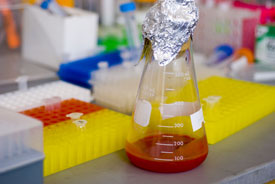|
|
|
Current News |
|
Chemistry A to Z |
|
About Internetchemistry |
Researchers Develop Simple Method to Create Natural Drug Products |
|
Until now, only the intricate machinery inside cells could take a mix of enzyme ingredients, blend them together and deliver a natural product with an elaborate chemical structure such as penicillin. Researchers at UC San Diego's Scripps Institution of Oceanography and Skaggs School of Pharmacy and Pharmaceutical Sciences and the University of Arizona have for the first time demonstrated the ability to mimic this process outside of a cell. A team led by Qian Cheng and Bradley Moore of Scripps was able to synthesize an antibiotic natural product created by a Hawaiian sea sediment bacterium. They did so by combining a cocktail of enzymes, the protein catalysts inside cells, in a relatively simple mixing process inside a laboratory flask. The research paper, along with a companion study describing a similar process achieved at Harvard Medical School with anti-tumor products, is published in the September (2007) issue of Nature Chemical Biology. |
|
"This study may signal the start of a new era in how drugs are synthesized," said Moore, a professor in the Center for Marine Biotechnology and Biomedicine at Scripps. "Assembling all the enzymes together in a single reaction vessel is a different way to make a complex molecule." While much more work is needed to employ this process on a mass scale, the achievement proves that such synthesis is possible relatively cheaply and easily-without the use of man-made chemicals-otherwise known as "green" chemistry. Most of the medicinal drugs on the market today are made synthetically. Researchers such as Moore and Scripps Oceanography's Bill Fenical have looked to the oceans as rich sources of new natural products to potentially combat diseases such as cancer. The antibiotic synthesized in Moore's laboratory, called enterocin, was assembled in approximately two hours. Such a compound would normally take months if not a year to prepare chemically, according to Moore. Rather than a "eureka" moment that led to the breakthrough, Moore said the process was achieved incrementally. The time-consuming work was spent beforehand identifying and preparing the enzymes that would ultimately catalyze the synthesis, also known as assembling the "biosynthetic pathway." "We've been preparing for some time now a 'biological toolbox,'" said Moore. "In this new process the enzymes become the tools to do the synthesis." An article in Nature Chemical Biology by Robert Fecik of the University of Minnesota indicated that "... Moore and co-workers have now taken biosynthetic pathway reconstruction to a new level." The new research also carries the potential to combine certain natural enzymes to produce new molecules that typically cannot be found in nature with the goal of developing new drugs. Moore calls these "unnatural natural products." Also joining Cheng and Moore in the research were Dario Meluzzi of the UC San Diego Skaggs School of Pharmacy and Pharmaceutical Sciences and Longkuan Xiang and Miho Izumikawa of the University of Arizona. The U.S. National Institutes of Health supported the research. |
|
|
|

